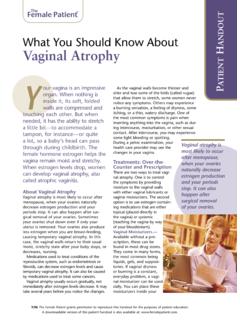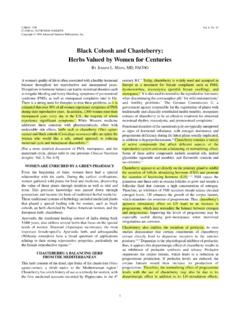Transcription of Ectopic Pregnancy and Catholic Morality
1 Ectopic Pregnancy and Catholic Morality A Response to Recent Arguments in Favor of Salpingostomy and Methotrexate Marie A. Anderson, Robert L. Fastiggi, David E. Hargroder, Rev. Joseph C. Howard Jr., and C. Ward Kischer Abstract. Respected Catholic ethicists, namely, William E. May, Christopher Kaczor, and Rev. Martin Rhonheimer, have recently defended methods for managing Ectopic pregnancies, such as the use of salpingostomy and metho- trexate, that very few Catholic moralists previously endorsed. This article examines the arguments for the revised assessments to determine whether there are sound reasons to believe that these two methods do not constitute the direct and immediate killing of innocent human beings. National Catholic Bioethics Quarterly (Spring 2011): 000 000. The moral debate regarding Ectopic pregnancies has increased in recent years. Respected Catholic ethicists, namely, William E. May, Christopher Kaczor, and Rev. Martin Rhonheimer, have begun defending the use of methods for managing Marie A.
2 Anderson, MD, FACOG, is an obstetrician and gynecologist in private prac- tice in northern Virginia. Robert L. Fastiggi, PhD, is a professor of systematic theology at Sacred Heart Major Seminary in Detroit. David E. Hargroder, MD, is a former transplant surgeon who now practices general, bariatric, and trauma surgery in Joplin, Missouri. Rev. Joseph C. Howard Jr., is a Catholic priest and a graduate student in moral theology and bioethics at the Catholic University of America in Washington, C. Ward Kischer, PhD, is professor emeritus of human embryology at the University of Arizona College of Medicine in Tucson. Address correspondence to Fr. Howard at 2011 The National Catholic Bioethics Center 667. The National Catholic Bioethics Quarterly Spring 2011. Ectopic pregnancies, such as salpingostomy and methotrexate, that very few Catholic moralists previously What has led to this change? Are the arguments advanced for this revised assessment convincing? These are the principal questions this article seeks to address.
3 The Medical Aspects of Ectopic Pregnancy The word Ectopic literally means out of place, from the Greek ek ( out of ). and topos ( place ). An Ectopic Pregnancy can be defined as one in which the human embryo does not implant in the endometrium (lining of the uterus), which is the normal site of implantation. Instead, the embryo implants somewhere outside of the endometrial cavity, such as the fallopian tube, cervix, ovary, or in the abdominal or pelvic cavity. 2 Between 1970 and 1992, cases of Ectopic pregnancies in the United States increased 600 In 1970, Ectopic pregnancies occurred in about per thousand pregnancies, but by 1992 this rate had risen to per thousand The associated mortality has decreased markedly, to deaths per thousand pregnancies, mainly because of early diagnosis and treatment before rup- ture. Nevertheless, ruptured Ectopic pregnancies continue to account for 6 percent of all maternal 1. Compare William E. May's treatment of the management of Ectopic pregnancies in his Catholic Bioethics and the Gift of Life (Huntington, IN: Our Sunday Visitor, 2000), 182 186, with his treatment of the same topic in the book's second edition (2008), 199 202.
4 In the first edition, May rejects salpingostomy and methotrexate as means for managing Ectopic pregnancies, whereas in the second edition he defends them. Unless otherwise specified, subsequent citations to May's Catholic Bioethics are to the first edition. Christopher Kaczor and Janet E. Smith note that only a minority of faithful theologians argue that salpingos- tomy, the procedure that removes the embryo but keeps the tube intact, does not involve a direct attack on the embryonic human being. In the same book, the authors also note that only a very small minority of faithful theologians argue that methotrexate does not cause a direct abortion. Janet E. Smith and Christopher Kaczor, Life Issues, Medical Choices: Questions and Answers for Catholics (Cincinnati, OH: Servant Books, 2007), 55. In a later article, however, Kaczor argues for the moral acceptance of the use of both salpingostomy and methotrexate in resolving Ectopic pregnancies. Kaczor, The Ethics of Ectopic Pregnancy : A Critical Reconsideration of Salpingostomy and Methotrexate, Linacre Quarterly (August 2009): 265 282.
5 For Rhonheimer's defense of salpingostomy and methotrexate, see Vital Conflicts in Medical Ethics: A Virtue Approach to Craniotomy and Tubal Pregnancies (Washington, DC: Catholic University of America Press, 2009), 90 119. 2. Peter J. Cataldo, Ectopic Pregnancy , in New Catholic Encyclopedia: Supplement 2009, ed. Robert L. Fastiggi (Farmington Hills, MI: Gale Cengage Learning, 2009), 253. 3. Eugene F. Diamond, A Catholic Guide to Medical Ethics: Catholic Principles in Clinical Practice (Palos Park, IL: Linacre Institute, 2001), 15. Ibid. 4. Sally F. Dorfman, Deaths from Ectopic Pregnancy , United States, 1979 to 1980, . 5. Obstetrics and Gynecology (September 1983): 334 338. 668. Anderson et al. Ectopic Pregnancy and Catholic Morality What has led to the increased rate of Ectopic pregnancies? Many researchers point to the rise of sexually transmitted diseases, the use of certain forms of reproductive technology ( , in vitro fertilization), and other risk factors such as drug use, smoking and Likewise, sexual promiscuity has led to an increase in pelvic inflammatory disease, which contributes to the higher incidence of Ectopic Other contributing factors are an age over 35 years and many lifetime sexual partners.
6 8 Various forms of contraception, such as intrauterine devices and progesterone contraceptive pills, as well as tubal ligations, are also cited as It can be argued that rise in Ectopic pregnancies is linked to behaviors that violate the divine and natural Most Ectopic pregnancies occur in the fallopian tubes, and less than 10 percent occur in other locations, such as the ovary or the Women who have had one prior Ectopic Pregnancy have a 10 percent risk of having another, and women who have had two or more have a 25 percent risk of having Some studies suggest that up to 70 percent of all Ectopic pregnancies resolve themselves sponta- neously; 13 others put the percentage closer to 64 percent,14 and still others between 40 and 64 Some physicians warn against relying on expectant management (watchful waiting and close monitoring instead of immediate treatment) because of the potential risk of tubal rupture,16 and others maintain that more than three- quarters of women who are diagnosed with Ectopic pregnancies are not candidates for medical or expectant management.
7 17. Diagnosing an Ectopic Pregnancy and then determining whether the unborn child is alive can be difficult. The diagnosis of an Ectopic Pregnancy begins by excluding a normal intrauterine Pregnancy . For a gestation of more than five and a half weeks, an intrauterine Pregnancy can be identified with nearly 100 percent 6. See Cataldo, Ectopic Pregnancy , 253; and Diamond, Catholic Guide to Medical Ethics, 15. 7. Diamond, Catholic Guide to Medical Ethics, 15. 8. Kurt T. Barnhart, Ectopic Pregnancy , New England Journal of Medicine (July 23, 2009): 379. 9. See May, Catholic Bioethics, 182; and John A. Rock, Ectopic Pregnancy , in Telinde's Operative Gynecology (Philadelphia: J. B. Lippincott, 1992), 412 414. 10. This is not to suggest that all women who have Ectopic pregnancies are morally culpable. It is, instead, a simple observation that the tremendous increase in Ectopic preg- nancies is apparently linked with various forms of sexual behavior that are opposed to the divine and natural law.
8 11. Barnhart, Ectopic Pregnancy , 379. 12. Ibid., 379 380. 13. Ibid., 385. 14. May, Catholic Bioethics, 183. 15. Kaczor, Ethics of Ectopic Pregnancy , 266. 16. Barnhart, Ectopic Pregnancy , 385. 17. Cataldo, 253. 669. The National Catholic Bioethics Quarterly Spring 2011. accuracy by transvaginal ultrasound findings, such as a gestational sac, yolk sac, fetal pole, and, later, cardiac motion (usually around six weeks).18. If evidence of intrauterine Pregnancy is not seen, then serial quantitative levels of the glycoprotein beta-human chorionic gonadotropin (B-hCG) must be obtained to determine whether the Pregnancy is healthy. In a healthy Pregnancy , the B-hCG. level rises 66 percent every two There is a correlation between the level of B-hCG and ultrasound findings. The discriminatory cutoff is that level of B hCG. at which evidence of intrauterine Pregnancy must be seen on an ultrasound, and it ranges from 1,500 to 2,500 If no intrauterine Pregnancy is visualized at this level of B-hCG, then an Ectopic Pregnancy must be suspected.
9 Sometimes, ultrasound evidence of an Ectopic Pregnancy is visualized outside the uterus. If fetal cardiac activity is present, then the unborn child is alive even though he or she is in an Ectopic location. If cardiac activity is not seen, then the unborn child either has died or is too small to be visualized on ultrasound. In this case, following serial B-hCG levels is indicated. If the B-hCG level does not rise appropriately, then it can be assumed that the unborn child has died. If the unborn child is dead, then any acceptable medical or surgical treatment can be employed. If there is any doubt regarding the state of the unborn child, and the mother's condition is stable, then tests should be repeated until clear evidence is obtained regarding whether the unborn child is alive. In certain cases progesterone levels can be somewhat helpful, because a pro- gesterone level of less than 5 ng/ml can rule out a normal Pregnancy with almost 100 percent accuracy, but it does not show whether that Pregnancy is an abnormal one in the uterus or at an Ectopic Progesterone levels in the context of the other tests give one more opportunity for objective evidence to assess the well-being of the unborn child.
10 This is important, because the next step in the usual diagnostic algorithm in the case of uncertainty is to evacuate the uterus, which constitutes a direct abortion if the unborn child is alive. Methods for Managing Ectopic Pregnancies The discovery of an Ectopic Pregnancy involves concerns of a medical, moral, and pastoral nature. Couples who desire to have children are faced with the likely death of their child. This is compounded by fears for the health and even the life of the mother. Catholic couples who wish to be faithful to the Church's moral teaching are often given conflicting reports on what the Church does or does not allow, and many have genuine concerns about how various treatments might affect future fertility. Many medical professionals, unfortunately, are not aware of the moral Beata Seeber and Kurt Barnhart, Ectopic Pregnancy , in Danforth's Obstetrics 18. and Gynecology, 10th ed., ed. Ronald S. Gibbs et al. (Philadelphia: Lippincott Williams and Wilkins, 2008), 74.






